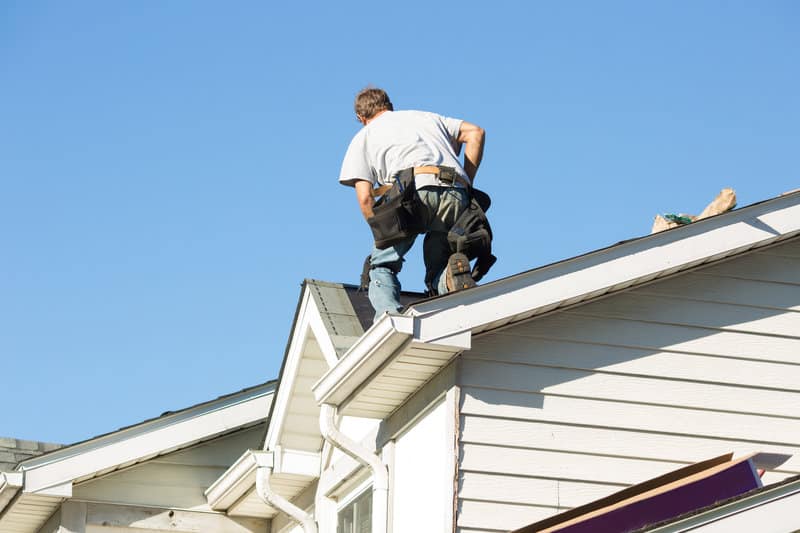
Do you know what you need to know about roofing safety?
Roofing work can be a dangerous task for many reasons. You’re often working high up off the ground, using potentially dangerous equipment. If you don’t follow safety practices well, you’re prone to injury or even death.
Fortunately, it’s not hard to learn roofing safety techniques. In this guide, we’ll break down everything you need to know to stay safe while working on a roof. Read on to learn more!
Top 10 Roofing Safety Hazards
Some roofing hazards may be obvious – others, not so much. Here are the main sources of danger that you’ll need to watch out for.
Low Stability
The roof needs to be stable enough to support your weight if you’re going to work on it. Is the roof completely intact, or is it rotten and falling apart? Does it bow under when the weather changes? Check the underlayment of the roof before you go up to work on it.
Insecure Ladder
Your ladder needs to be secure and placed well before you go up on the roof. Make sure the top and the feet of the ladder are stable. Ladder falls don’t just cause injury – they cause a surprising number of deaths each year. Don’t become one of those statistics.
Bad Weather
Some conditions make it harder to work on a roof. In really bad weather, you should avoid doing any roofing work at all.
Wind, ice, and snow can all lead to serious accidents while roofing. Shingles and other roof materials can easily become slippery. If you’re working on a membrane roof, you should avoid it completely in any of these conditions, as it can get extremely slippery.
Presence of Holes
Holes in the roof aren’t always accidental. You’ll also need to watch out for manmade holes such as skylights. If you don’t have any equipment to protect you from a fall, going through one of these holes can be deadly.
Lack of Edge Awareness
It’s important to always know exactly where the roof edge is. Sometimes, you can become distracted by your work and fail to notice the edge of the roof until it’s too late.
Poor Training
Most roof work requires at least some level of training and knowledge. If you haven’t been properly trained to use certain tools and techniques, you’re more likely to run into problems.
You might not even be the cause of the problems. Working with a partner who lacks training can also be a roof safety hazard.
Lack of Equipment
If you don’t have the right fall protection equipment – or don’t use the equipment you have correctly – this can also lead to problems. For example, if you’re using a harness but it’s not properly secured, you will have issues.
Vision Blocks
When your line of sight is blocked, roof work becomes more dangerous.
Chimneys, vents, and other blockers can keep potential hazards out of your sight until it’s too late.
Steep Pitch
Steep roofs are more dangerous than flat ones. You’ll fall more easily from a roof with a high pitch. Make sure you use fall protection on a steep roof.
Split Level Roof
It can be tempting to think the fall won’t be so bad if you’re working on a split-level roof. However, you can also get injured by falling from one roof onto a lower level.
Roofing Safety Best Practices
No matter what kind of hazards you’re up against, follow these safety practices to make sure you can get the job done right.
Keep the Work Area Clean
A clean, organized work area goes a long way toward promoting roofing safety.
Keep kids, pets, and other distractions away while you work. Look for potential hazards before you start. For example, identify the locations of power lines that could get in the way of the job.
Avoid Falls
Falling is the number-one danger when it comes to roof work. Of course, the cause of the fall may be different each time, but the safety tip is the same: take precautions to avoid falling altogether.
Avoid working if the roof is wet or conditions are bad. Remove debris, tools, and dirt that could cause you to slip or trip. Wear the right shoes: boots with soft soles are ideal for traction.
If the roof is pitched, or other hazards abound, put on a safety harness and net, r add rails to the edge of the roof.
Always take extra care with ladder setup, and wear a helmet at all times.
Use Ladders Safely
Ladder safety is so important, it’s deserving of its own section here.
Make sure your ladders meet all the local codes and regulations. They should be OSHA-approved and ready to use. Check the ladder each time you start work: if it’s broken or damaged, don’t use it – replace it.
To set it up properly, put the base on a level, solid ground. Avoid placing the ladder on a driveway that slopes down from the roof – these can be a serious hazard.
At the top, use a brace made of plywood to secure it, or tie off the top. Make sure it’s resting on a solid support. The ladder should extend about 3 feet above the eaves of the roof, so you have something to hold onto when you get on the ladder to climb down.
To climb it safely, face the ladder and go up one rung at a time. Don’t add too much weight to a ladder, and don’t slide down it to get off. Always get a ladder that’s the correct size – it shouldn’t be at too steep an incline.
Be Careful Around Electricity
When working around electrical wires, take extra caution. Electricity can easily transmit from a wire to a ladder from a few feet away. If wires are nearby, choose a wood or fiberglass ladder instead of a metal one.
Everyone who works on a roof is responsible for their own safety. Follow these best practices, and you’ll avoid potential danger.
For many roofing jobs, though, it’s best to leave it to the professionals. Check out our roofing estimates here.

